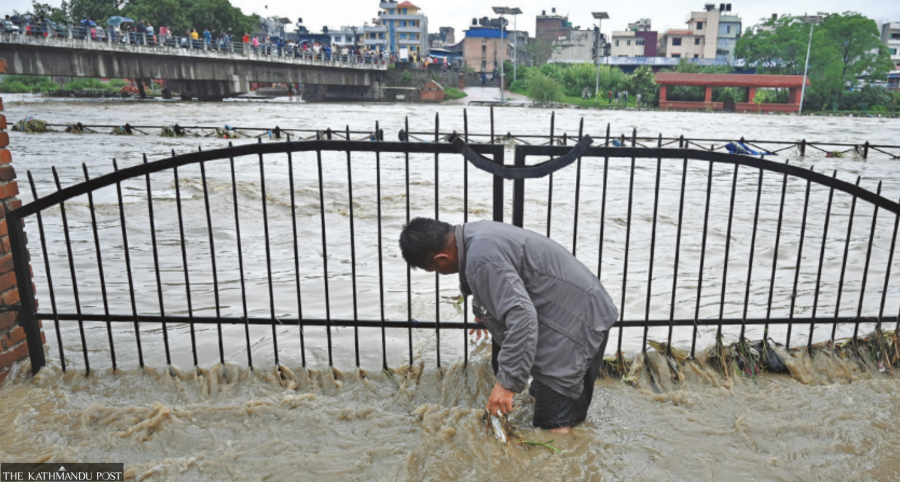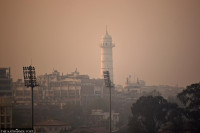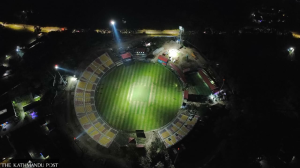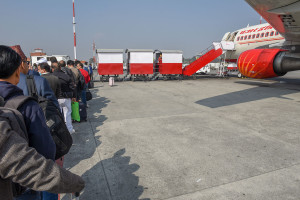Climate & Environment
Met department predicts above-average monsoon rainfall this year
Disaster authority steps up preparations, coordination with security agencies to respond to floods and landslides.
Post Report
Nepal is expected to witness above-average rainfall in the upcoming monsoon, according to a seasonal outlook issued by the Department of Hydrology and Meteorology on Wednesday.
The prediction is in line with the regional climate outlook jointly prepared by all nine National Meteorological Services of South Asia, which is above-normal rain in the 2025 monsoon.
According to the four-month forecast [from 1 June to 30 September] issued on Wednesday, both maximum and minimum temperatures are expected to be higher than average across the country.
“Most parts of the country are expected to receive above-average rainfall in the upcoming monsoon season,” reads the outlook issued by the department. “Both maximum and minimum temperatures across the country are likely to be higher than average.”
According to data provided by the department, there is a 55 to 65 percent chance of above-average rainfall in the eastern region of Karnali province, the northern region of Lumbini province, and most parts of Gandaki province. Likewise, there is a 45 to 55 percent chance of above-average rainfall in the southern region of Sudurpaschim province, the western region of Lumbini province, the northern region of Gandaki province and the northern region of Bagmati and Koshi provinces. In the eastern and southern regions of Madhesh province, the chance of normal rainfall is 35 to 45 percent. The remaining parts of the country could witness above-average rain, and the chance is only 35 to 45 percent.
Likewise, there is a 55 to 65 percent chance of above-average maximum temperatures in the northwestern region of Sudurpaschim province, northern areas of Karnali and Lumbini provinces, western parts of Gandaki, western parts of Madhesh province and central areas of Bagmati province. Similarly, there is 35 to 45 percent above-average rainfall in the eastern region of Madhesh province and the central region of Gandaki province. The rest of the country has a 45 to 55 percent chance of experiencing above-average maximum temperatures.
For minimum temperatures, the outlook suggests a 55 to 65 percent chance of above-average readings in most parts of Karnali and Bagmati provinces, the central Lumbini, western Madhesh, and Tarai areas of Koshi province. The southwestern region of Sudurpaschim, the northern Gandaki, and northern Koshi have a 35 to 45 percent chance of above-average minimum temperatures. The rest of the country has a 45 to 55 percent chance of above-average minimum temperatures.
The forecast is based on global and regional models from centres that produce hydrometeorological forecasts under the World Meteorological Organisation, along with data from the South Asian Seasonal Climate Outlook forum.
Above-average rainfall during the monsoon season helps boost crop yields and provides a much-needed lift for the country’s struggling economy. However, it could also spell incidents of disasters—landslides and flash floods in mountains and hilly regions and flooding in the Tarai region.
The department had forecast above-average rainfall in last year’s monsoon, which was validated by actual data. Also, the predicted higher-than-average maximum and minimum temperatures for most places were confirmed by recorded data.
The monsoon normally enters Nepal around June 13 and typically lasts until September 23. In the four months of the monsoon—June, July, August, and September—the country receives an average of 1,472 mm of rainfall.
Nepali meteorologists also anticipate an early start to the monsoon this year.
Meanwhile, officials at the National Disaster Risk Reduction and Management Authority (NDRRMA) said they have started preparing to respond to possible disasters to prevent a repetition of past weaknesses.
“We have already held multiple meetings with stakeholders, including security agencies—the Army, Police and Armed Police Force—and discussed the possible worst-case scenarios,” said Ram Bahadur KC, spokesperson for the NDRRMA. “We will also prepare a risk assessment, and preparation will start accordingly.”
Every year, floods and landslides cause huge losses to life and property, but the country is poorly prepared to deal with disasters.
Nepal is one of the world’s most vulnerable countries to the climate crisis, and for over a decade, it has witnessed multiple extreme weather events.
Evidence suggests the maximum temperature in Nepal is rising faster, at 0.056 degrees Celsius a year, compared to the global average of a rise of 0.03 degrees Celsius a year.
Experts warn that extreme weather events such as excessive rainfall in a short span, prolonged rains after the monsoon, droughts, and above-average winter temperatures have become more common in Nepal.
In recent years, the country has been receiving more rainfall in short durations—an abnormal phenomenon that is slowly becoming the new normal. Experts say changes in rainfall patterns, which have become severe and erratic in the past few years as a result of climate change, have contributed to extreme weather events like floods and landslides annually.




 8.12°C Kathmandu
8.12°C Kathmandu










